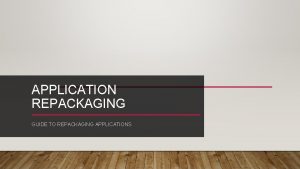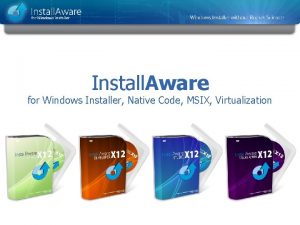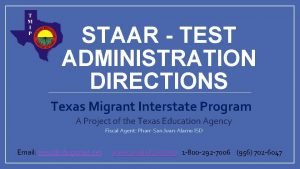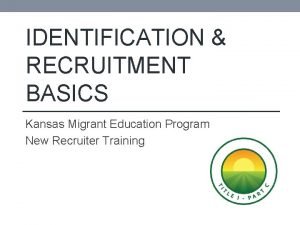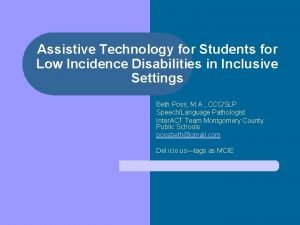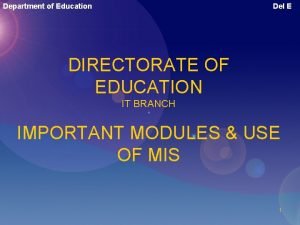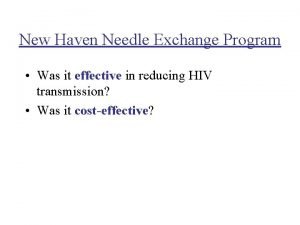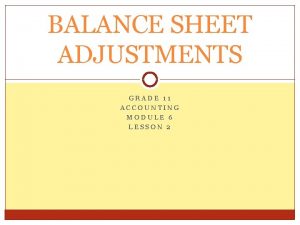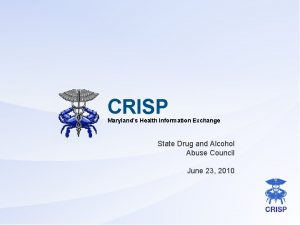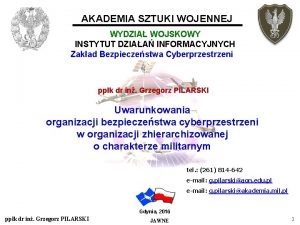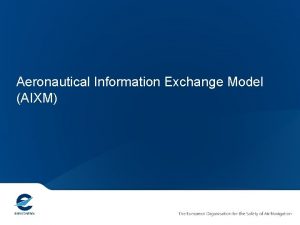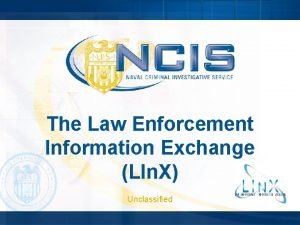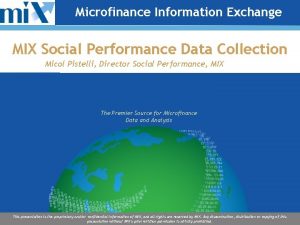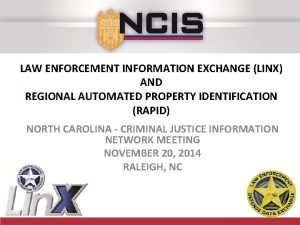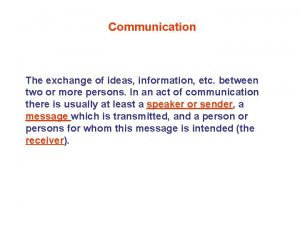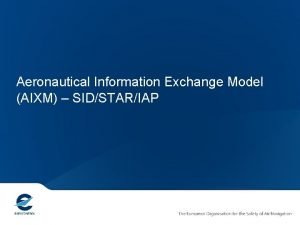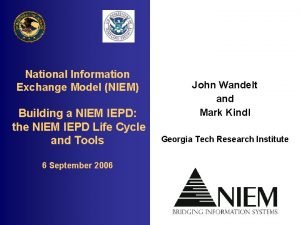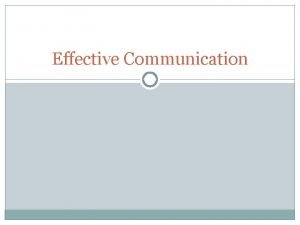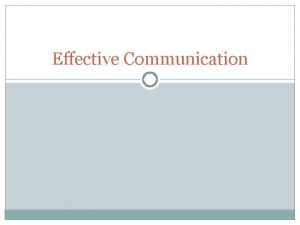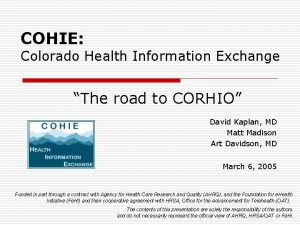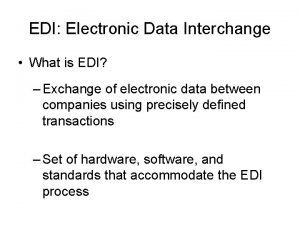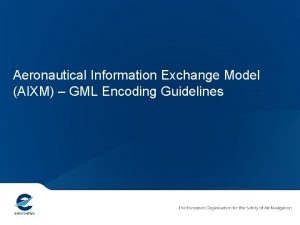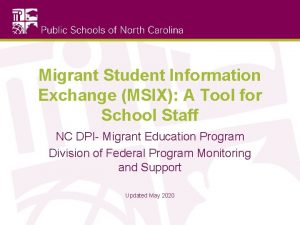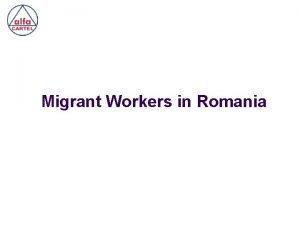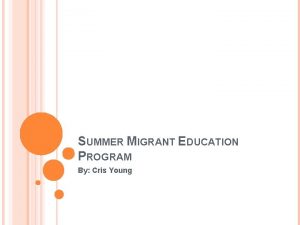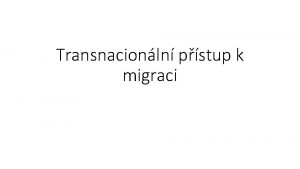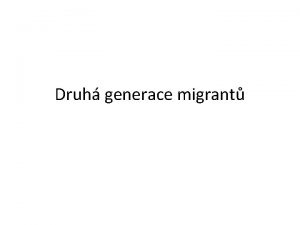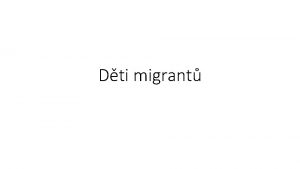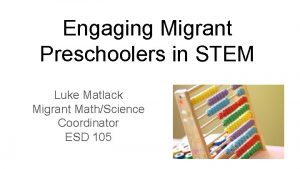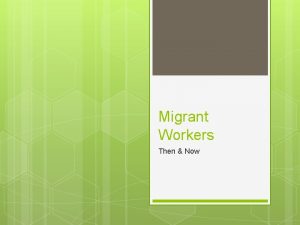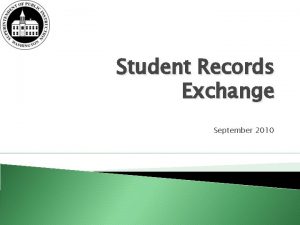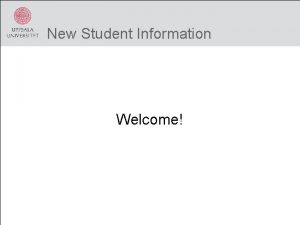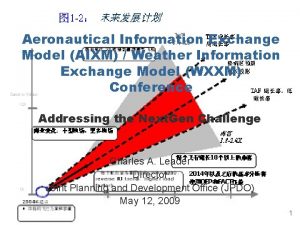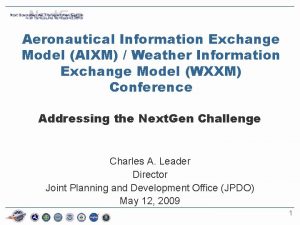Module 12 Migrant Student Information Exchange MSIX New



































































- Slides: 67

Module 12: Migrant Student Information Exchange (MSIX) New Directors’ Orientation Tutorial

Table of Contents Section Slide # Getting Started 3 Overview of the Migrant Student Information Exchange (MSIX) 9 Purpose and Functionality of MSIX 14 Implementing MSIX 28 Student Privacy 38 MSIX Best Practices 48 Wrapping Up 62 2

Getting Started In This Section • Tutorial Objectives • How to Use the Tutorial • Icons to Guide You • Key Readings and Resources 3

Tutorial Objectives Module 12 will enable new state directors to 1. understand the functionality of MSIX, 2. understand the roles and responsibilities of MSIX users, 3. understand the impact of poor data quality, 4. review current policies and procedures of state MSIX implementation, and 5. develop strategies for improving MSIX implementation. 4

How to Use the Tutorial For optimal benefit from the tutorial, you should • allow sufficient time to read the slides, reflect on the information, and complete all activities on the slides or on the Quick Resource and Reflection Sheets (QRRS) that can be downloaded as worksheets; • read each slide as well as the information referenced in the slides; • engage with the “What Do You Think? ” slides to facilitate interaction with the information (Answers will be provided directly following each of these slides. ); 5

How to Use the Tutorial For optimal benefit from the tutorial, you should (continued) • pause to reflect on your state program at the “Check-in” slides (A QRRS document will typically accompany these. ); • complete the “Pop Quiz!” slides to reinforce key concepts; • review your state’s Migrant Education Program (MEP) documents and reports as directed; • develop an action plan using the worksheets provided; • add actionable items to your MEP planning calendar (QRRS 14. 2); and • contact your OME Program Officer follow-up questions. 6

Icons to Guide You The following icons will guide you in making the best use of this tutorial: What Do You Think? Check-in Pop Quiz! Quick Reference and Reflection Sheet (QRRS) Action Planning Calendar Item 7

Key Readings and Resources You should have these documents readily available while completing the module, as the module will refer to these documents for more complete information on various topics. • MEP Guidance on the Education of Migratory Children under Title I, Part C of the Elementary and Secondary Education Act of 1965 • MSIX website • MSIX User Guide on the Minimum Data Elements • Records Exchange Leading Practices Guide 8

Overview of the Migrant Student Information Exchange In This Section • What is MSIX? • Why is MSIX Needed? • Migrant Student Record Exchange Goals 9

Why Migrant Student Records Exchange? In Section 1308(b) of Title I, Part C of ESEA, as amended, Congress requires the Department (ED) to assist States in developing effective methods for the electronic transfer of student records and in determining the number of migratory children in each State. Further, Section 1308(b)(2)(A) of the statute requires ED to ensure the linkage of state migrant student record systems in order that health and educational information about all migratory students may be electronically exchanged among the States. To implement these requirements, ED has implemented the Migrant Student Information Exchange Initiative, whose primary mission is to ensure the appropriate enrollment, placement, and accrual of credits for migrant children. 10

What is the Migrant Student Information Exchange? The Migrant Student Information Exchange (MSIX) is the technology that allows states to share educational and health information on migrant children who travel from state to state and who as a result, may have student records in multiple states' information systems. MSIX works in concert with states’ own existing migrant student information systems to fulfill its mission of helping to ensure the appropriate enrollment, placement, and accrual of credits for migrant children nationwide. 11

Why is MSIX Needed? Because of the highly mobile lifestyles of migrant families, schools often see migrant students enter and exit with little or no notice. • Without timely and accurate data, migrant children may experience o A delay in enrollment, o Incorrect grade or course placement, o Credit accrual issues, o Unnecessary duplication of immunizations, and/or o Disruption of MEP services. 12

MSIX Goals MSIX is a collaborative effort to assist ED and states to: • Establish standards for the minimum education and health data that each state must collect and maintain in its own existing electronic state migrant student records system; • Develop an electronic exchange to link all states’ migrant student record systems, facilitating the consolidation of migrant students’ education and health information. • Create a web-based, consolidated, migrant student record that can be used by authorized school personnel to facilitate school enrollment, grade and course placement, and the accrual of secondary school course credits; and • Produce useable information on the migrant student population. 13

Purpose and Functionality of MSIX In This Section • MSIX Goals • MSIX Purpose • MSIX Functionality • MSIX Data Flow • Minimum MSIX Data Elements • MSIX Student Data Reports • MSIX - Use a Common Language 14

MSIX Goals The goals of MSIX are to: 1. Create an electronic exchange for the transfer of migrant student education and health data among the states; 2. Ensure the use of the consolidated migrant student record for the purposes of enrollment, placement, and accrual of credit of migrant students in school and migrant education projects; and 3. Produce national data on the migrant population. 15

MSIX Purpose MSIX is designed to link existing state migrant data record systems in order to collect, consolidate, and make critical education data available to staff of school and LEAs in which migrant students enroll. See QRRS 12. 1 – What do you know about MSIX? 16

MSIX Functionality The following graph is a conceptual design of how MSIX system works. U. S. Department of Education (Deloitte Consulting LLP). Migrant Student Information Exchange Train-the-Trainer Regional User Conference. Accessed from: https: //msix. ed. gov/msix/training. Corner/User. Conference. Presentation/User. Conf 4_Presentation. pdf 17

MSIX Functionality Review the table below for information on what MSIX is designed to do. MSIX does not Leverage available information provided by the states to ED’s Education Data Exchange Network (EDEN) Replace existing state data record systems Contain the minimum data elements (MDE) necessary for the proper enrollment, grade and course placement, and accrual of credits for migrant children Produce a consolidated record for each migrant child (in the system) that contains information from each (participating) state in which the child was enrolled Provide for the exchange of migrant student data and records in a secure uniformat 18

MSIX Data in MSIX comes from four categories of information already collected through state migrant-specific databases. 1. Demographics 2. Enrollments 3. Course History 4. Assessments 19

MSIX Data The graphic below illustrates the types of data MSIX is designed to collect. Enrollments Certificate of Eligibility (COE) Demographic s Student forms, school database MSI X Data COE, health forms, school information, school/district databases Course History Student forms, school information, school/district database Assessments 20

MSIX Data Flow In addition to the state’s migrant-specific database, health and school information may come from the state’s general education student information system/state database (see slide 19). • The flow of information through electronic data systems avoids time-consuming manual data entry or re-entry that can delay the timely transfer of accurate data to the MSIX system. o The lack of access to the state system by the migrant-specific database seems to be the biggest barrier. o In order to get access to the state’s general education student information system, the state MEP office needs buy-in from key stakeholders at the SEA. o If there is a conflict of information in the different systems, the state MEP office should be the authoritative source of migrant student data in all systems. 21

MSIX Data Flow Data transferred from the states’ migrant databases into MSIX are used to generate a Consolidated Student Record to assist school staff in: • Placing students in the correct grade or courses, • Verifying student immunization history, and • Providing a record to give to parents or guardians of migrant students upon school withdrawal. Info is collected from family, school, local and state databases Info is entered into state’s migrant-specific database State’s migrant – specific database uploads data to MSIX creates a CONSOLIDATE D STUDENT RECORD for MSIX users to view and use in order to place students in correct grade and classes 22

Minimum MSIX Data Elements • MSIX does not replace state MEP data systems. • States’ systems regularly transfer files to MSIX using a predefined format that groups the Minimum Data Elements (MDEs) to be transferred to MSIX for each migrant child in a relational format. o MDEs are data fields that states must collect and maintain in their migrant student databases for each of their eligible migrant children in order to make those data available to other states via MSIX. For a list of the current MDEs, refer to the MSIX website. 23

Minimum MSIX Data Elements States transmit all applicable MDEs from their state migrant-specific databases when: • Information on newly identified migrant students is collected, and • Updated information for previously identified migrant students is collected. 24

MSIX Student Data Reports MSIX generates reports related to student information and mobility, including: • MSIX Student Data Count – counts distinct students, near matched students, and those with records in multiple states; • Student Demographics – counts students by age, gender, birth location, and Consolidated Student Record (CSR) flag; • Student Enrollments by MDE Type – counts grade, enrollment type, various enrollment flags, and MEP project type; • Student Enrollments in Multiple States – counts of students in the state who have enrollments in other states; • Grade Retention Counts – counts students who were retained in the same grade for two academic years; 25

MSIX Student Data Reports • Missed Enrollment – counts of missed enrollment identified following a student’s qualifying move; • Student Assessments - counts of assessment records by assessment type; • Student Course History – counts of course history records by course type; • Child Counts Data – counts of Category 1 and Category 2 students for the current or previous school year as defined by the CSPR criteria; • General Move From – counts of student moves out of the state; and • General Move To – counts of student moves into the state. For more information, see the MSIX Report Manual 26

MSIX – Use a Common Language Cohesion of purpose and accuracy of implementation can be facilitated by ensuring that everyone involved with the state MEP migrant-specific database and MSIX share a common language. • Don’t make assumptions about staff’s understanding of acronyms and key terms. • Establish a glossary of key terms, and use terms consistently. • Don’t treat the glossary as a static document. o As the need to clarify terms arises, add definitions to the glossary. 27

Implementing MSIX In This Section • Establishing MSIX Policies and Procedures • Roles and Responsibilities 28

Establishing MSIX Policies and Procedures States need to have a Policy & Procedures document in place to guide MSIX implementation and practices. At a minimum, SEAs will want to consider including the following information to: • Establish a staffing plan; • Define roles and responsibilities; • Define MSIX Rules of Behavior; • Ensure timely activation/deactivation of user accounts; • Ensure proper access of records; See QRRS 12. 2 – MSIX Policies and Procedures Handbook 29

Establishing MSIX Policies and Procedures • Update state MEP data systems that feed MSIX in a timely manner; • Manage accuracy of state MEP data; • Manage student move alerts; • Conduct worklist maintenance (e. g. , response and resolution times, delegation of worklist items, and escalation process); • Ensure MSIX data is used properly for timely enrollment and accurate placement and credit accrual; • Communicate with parents regarding student records; and • Establish common language. 30

Roles and Responsibilities The ESEA requires SEAs to promote interstate and intrastate coordination by providing educational continuity through the timely transfer of pertinent school records (including health information) when children move from one school to another, whether or not the move occurs during the regular school year. • The MSIX consolidated student record is available to use for migrant student enrollment, placement, and credit accrual. 31

Roles and Responsibilities Typically, the SEA will have an MSIX data administrator to coordinate and oversee the implementation of the statewide MSIX efforts. The MSIX data administrator works with the MEP state director and state data staff to: • Establish policies and procedures, • Define statewide roles and responsibilities, • Coordinate the transfer of state migrant data to MSIX, • Establish quality control processes and procedures, and • Serve as the state MSIX liaison to the federal MEP MSIX. 32

Roles and Responsibilities MSIX is intended to significantly help front-line educators who need access to current migrant student records to aid in enrollment, placement, and credit accrual. Front-line educators are typically: • Guidance counselors, • MEP data entry staff, • Recruiters, • School registrars, and/or • Teachers. 33

Roles and Responsibilities • Primary users have access to MSIX to initiate changes in student records within the system, while secondary users may only view the records that MSIX maintains. • State User Administrators and State Data Administrators are located at the SEA level. • Depending on the size of the migrant student population within a state and/or the way the SEA organizes its administration of the MEP, states may have also primary users and data administrators at the regional and/or local levels. • See the chart on slide 35 to see the functions assigned to each MSIX role. 34

Roles and Responsibilities The chart below illustrates some typical responsibilities associated with each identified role. As previously noted, the primary and secondary users will usually be school and district staff. 35

Roles and Responsibilities • MSIX is for official use only. • The SEA must ensure that all users adhere to the Rules of Behavior established to maintain the security of the system and student data. SEAs should establish procedures for communicating and monitoring implementation of the Rules of Behavior, including o MSIX system monitoring, o MSIX security controls, o user credentials, o protection of MSIX information, and o other security considerations. 36

Roles and Responsibilities • MSIX is a U. S. Department of Education computer system and is subject to Department monitoring and auditing. • Users do not have aright of privacy when using the MSIX system. 37

Student Privacy In This Section • Student Privacy Basics • Family Educational Rights and Privacy Act • Federal Information Security Management Act • MSIX and Student Privacy 38

MSIX and Student Privacy MSIX is developed in accordance with federal requirements designed to safeguard the privacy and security of education data. MSIX only collects the MDEs necessary for: • Correctly identifying the migrant student, and • Enrollment, placement, and credit accrual purposes. o Only authorized personnel may access the MSIX system. Family Education Rights and Privacy Act of 1974 (FERPA) Federal Information Security Management Act of 2002 (FISMA) 39

Family Educational Rights and Privacy Act The Family Educational Rights and Privacy Act (FERPA) of 1974 protects the privacy of student education records. • Except as FERPA otherwise permits, SEAs, LOAs, and schools generally must have written permission from the parent or eligible student to release information from a student’s education record. o For exceptions relative to disclosure of records to implement MSIX and for disclosure of the MSIX Consolidated Student Records for “routine uses, ” see slides 42 -44. • Parents or eligible students have the right to review the student’s records. • Parents or eligible students have the right to request that a school correct records. Family Education Rights and Privacy Act of 1974 (FERPA) 40

Federal Information Security Management Act The Federal Information Security Act (FISMA) was enacted as part of the E-Government of 2002. • FISMA requires federal agencies to implement a mandatory set of processes and system controls designed to ensure the confidentiality, integrity, and availability of information maintained in Federal electronic systems. o The processes and systems controls each federal agency uses must follow Federal Information Processing Standards, National Institute of Standards and Technology standards, and other requirements pertaining to federal information systems, such as the Privacy Act of 1974. 41

MSIX and Student Privacy FERPA permits SEAs, LEAs, and LOAs to use MSIX to exchange personally identifiable information contained in education records on migratory children without written parental consent as long as the information is used only for official MEP purposes and is in accordance with the Rules of Behavior set forth in the Student Records Exchange Polices and Procedures Manual. ED Memorandum to State Directors of Migrant Education on FERPA and MSIX FERPA (General Education Provisions Act, Sec. 444) 34 CFR § 99. 35 72 FR 68572 -76 42

MSIX and Student Privacy • Information from MSIX records may be disclosed for “routine uses” to facilitate a student’s: o Participation in the MEP, o Enrollment in school, o Grade or course placement, o Credit accrual, and o Unique student match resolution. 43

MSIX and Student Privacy • Generally, no other disclosures of a student’s name or other personally identifiable information may be made from MSIX without the prior written consent of the parent or student. ED Memorandum to State Directors of Migrant Education on FERPA and MSIX FERPA (General Education Provisions Act, Sec. 444) 34 CFR § 99. 35 72 FR 68572 -76 44

MSIX and Student Privacy Under FERPA, parents and eligible students have the right to access student records. • As part of the state’s Student Records Exchange Policies and Procedures Manual, each SEA should outline procedures for districts that address: o Student or parent requests for access to student records, and o Student or parent disputes of student records. 45

MSIX and Student Privacy Below is a process chart for steps to be taken if the migrant student or parent expresses that the MSIX Consolidated Student Report has an error in their child’s information. U. S. Department of Education (Deloitte Consulting LLP). Migrant Student Information Exchange Train-the-Trainer Regional User Conference. Accessed from: https: //msix. ed. gov/msix/training. Corner/User. Conference. Presentation/User. Conf 4_Presentation. pdf 46

MSIX and Student Privacy • Student data should be protected, and access should be permitted only for those who are authorized and who are acting on behalf of the student. • Procedures for activating and deactivating MSIX user accounts are crucial to the continued security of student data. • SEAs should establish procedures for clarifying responsibilities related to: o Approving user accounts for local staff and setting access level, o Administering user account id and passcode, o MSIX user verification, o Deactivating/deleting user accounts within a set time period after leaving MSIX, and o Action to be taken for violation of rules of behavior. 47

MSIX Best Practices In This Section • Parent Communication • Quality and Timeliness of Data • Implementation Challenges 48

Parent Communication Having a statewide plan in place for districts and schools to use to inform parents of migrant students about the benefits of MSIX can facilitate their involvement in obtaining and providing student records each time their children transition between school systems. • Use recruiters and school and migrant employer sites to provide parents brochures about MSIX brochure (English version) MSIX brochure (Spanish version) 49

Parent Communication • Include information about MSIX in SEA and LOA PAC meetings. • Assuage privacy concerns by providing information on FERPA and FISMA regulations. • Provide parents with their child’s MSIX ID number. • Provide parents or guardians with their child’s Consolidated Student Record upon school withdrawal. • Assuage privacy concerns by providing information concerning FERPA and FISMA (see slides 39 -47). • Establish a process for allowing students and parents to review MSIX data. 50

Pop Quiz! If a parent informs you that the family is leaving the area, what can you do? a. Send an email notification through MSIX to the new school. b. Let parents know that they should tell the new school their child is in MSIX. c. Provide parents with the MSIX ID and a copy of the MSIX Consolidated Student Record. d. All of the above. 51

Pop Quiz! – Response All of the above responses are correct. • Through the MSIX Student Move Alert system, schools can notify one another of impending student movement. • If the enrolling school knows that a child is in the MSIX system, the school can access his/her MSIX records to expedite enrollment and placement. • Providing parents with their child’s MSIX Consolidated Student Record will give them an artifact of their student’s educational record and provide the enrolling school with information that will expedite enrollment and placement. 52

Quality and Timeliness of Data To facilitate proper decisions about migrant students’ enrollment and placement in classes, courses, and MEP support programs, it is important that data collection is timely and accurate. When establishing procedures for data quality: • Establish timelines and key dates for the timely entry of student data into the state MEP data system, such as those for: o Enrollment, o Placement in classes, courses, MEP support programs, o End of grading period and other key assessment dates, and o School enrollment and withdrawal; 53

Quality and Timeliness of Data • Customize communication and training to specific MSIX user responsibilities. o Training on collecting information about students’ history, academic performance, and health needs will be different than training for data entry. o Even if there are instances when the same staff need training for both, consider not lumping all information together. Highlight the importance of the role played by the data collector and the data entry staff separately. 54

Quality and Timeliness of Data • Establish processes, timelines, and responsibilities for cleaning data regularly to ensure: o Accuracy, o Timeliness of data transfers, and o Resolution of discrepancies among records. • Convene a data quality team charged with periodically reviewing procedures to promote data accuracy; and 55

Quality and Timeliness of Data • Minimize differences in interpreting courses, assessments, and other Minimum Data Elements. States that exchange students in large numbers should consider mechanisms for: o Establishing contacts across states, o Collaborating to develop a course description mapping mechanism that provides uniformity among the courses, and o Having staff in the affected SEAs negotiate placement of students when data interpretations differ. 56

What Do You Think? • What are the challenges to obtaining accurate data? • What are some factors that contribute to errors in data entry? • What is the impact of inaccurate or incomplete data? See QRRS 12. 3 – Data Quality 57

What Do You Think? – Reflection Identify which of the challenges you identified are addressed in the following two slides. 58

Implementation Challenges In 2011, the Records Exchange Advice, Communications and Technical Support (REACTS) Team conducted a workgroup session consisting of 18 state MEP representatives with varying degrees of MSIX experience to identify challenges that state MEPs face and to formulate some common solutions. The result was the document, Records Exchange Leading Practices. See QRRS 12. 4 – Do You Know What the Common Challenges to Implementing MSIX in Your State Are? 59

Implementation Challenges The Records Exchange Leading Practices addresses 11 identified challenges. 1. Students and families provide inconsistent data. 2. MEP staff incorrectly enter data into state migrant-specific database. 3. States interpret data elements differently. 4. States have difficulty resolving incorrect date of birth. 5. Staff incorrectly flag students as migrant. 6. State MEPs have limited access to state student record systems. 7. MEP staff do not enter information in a timely manner. 60

Implementation Challenges 8. State MEPs do not have a way to verify employment of MSIX users. 9. State MEPs do not have a plan for effectively rolling out MSIX. 10. Some potential users do not see the value of MSIX. 11. Parents and students are not aware of MSIX. 61

Wrapping Up In This Section • Key Concepts • Action Planning • For More Assistance • Resources 62

Key Concepts • Migrant students often enter and exit schools with little or no notice, due to the highly mobile lifestyles of migrant families. • SEAs are required to promote interstate and intrastate coordination by providing educational continuity through the timely transfer of pertinent school records (including health information) when children move from one school to another. • MSIX is designed to link existing state migrant data record systems in order to consolidate and make migrant student education data available. • Data transferred from the states’ migrant databases into MSIX are used to generate a Consolidated Student Record that can assist school staff in timely enrollment, and accurate placement and credit accrual. 63

Action Planning • In what phase of MSIX implementation is your state? • What strategies can be implemented to improve data quality issues? • To what degree are schools accessing MSIX to generate an MSIX Consolidated Student Record when new migrant children arrive to enroll? See QRRS 12. 5 – MSIX Action Planning Add any actionable items to your MEP planning calendar. 64

For More Assistance with MSIX For questions about planning and implementing your state-wide MSIX, contact • Migrant Record Exchange Initiative Email: Patricia. meyerholen@ed. gov For MSIX Help Desk support, contact • Technical or General MSIX Information Email: msixsupport@deloitte. com Phone: (866) 878 -9525 65

Resources for MSIX • MEP Guidance on Education of Migratory Children under Title I, Part C, of the Elementary and Secondary Education Act of 1965 – Explanation of guidelines to implement the laws and regulations related to the MEP • MSIX Website – Access to MSIX login, user manuals, and training materials • MSIX User Guide on the Minimum Data Elements – A comprehensive tool to assist MSIX users in understanding the MDEs, in terms of origin, business rules and use. • Records Exchange Leading Practices Guide – A reference guide for state MEP representatives regarding data correction and consistency, data collection, creating a records exchange program, and communication and training as it relates to MSIX and records exchange. 66

Migrant Education Program Resources • MEP Officers – List of OME contact information (https: //results. ed. gov/about/contact) • Glossary of Terms – Alphabetical listing of key terms applicable to migrant education (https: //results. ed. gov/idrmanual/section/glossary) 67
 Msix app attach
Msix app attach Msix packaging tool driver
Msix packaging tool driver Msix installer
Msix installer Staar test directions
Staar test directions Florence leona thompson
Florence leona thompson Migrant mother analysis essay
Migrant mother analysis essay Aude ferran
Aude ferran St patrick's college peter skrzynecki poem
St patrick's college peter skrzynecki poem Complexe moteur migrant
Complexe moteur migrant I wish that i were old enough to vote dgp
I wish that i were old enough to vote dgp Reverse hierarchical diffusion example
Reverse hierarchical diffusion example Cultural landscape ap human geography example
Cultural landscape ap human geography example Kansas migrant education program
Kansas migrant education program Migrant info point
Migrant info point Washington state migrant council
Washington state migrant council Circulation ap human geography
Circulation ap human geography Real exchange rate vs nominal exchange rate
Real exchange rate vs nominal exchange rate Voluntary exchange activity the pearl exchange
Voluntary exchange activity the pearl exchange Gas exchange key events in gas exchange
Gas exchange key events in gas exchange Use the exchange market intervention figure 43-1
Use the exchange market intervention figure 43-1 C device module module 1
C device module module 1 Wise foreign exchange program
Wise foreign exchange program Monash overseas study
Monash overseas study Xlri foreign exchange
Xlri foreign exchange Exchange letter format
Exchange letter format Student exchange program ipsf
Student exchange program ipsf Assistive technology for low incidence disabilities
Assistive technology for low incidence disabilities Edirectorate
Edirectorate New world drinks columbian exchange
New world drinks columbian exchange New haven needle exchange
New haven needle exchange New world drinks columbian exchange
New world drinks columbian exchange Did pumpkins come from the new world or old world
Did pumpkins come from the new world or old world Lrere
Lrere Accounting grade 12 fixed assets
Accounting grade 12 fixed assets Grade 11 accounting adjustments
Grade 11 accounting adjustments Module 9 old and new
Module 9 old and new What do you did last weekend
What do you did last weekend We ...... a big piece of wood last saturday. (see)
We ...... a big piece of wood last saturday. (see) Clearinghouse student tracker
Clearinghouse student tracker Class maths student student1 class student string name
Class maths student student1 class student string name National student clearinghouse student tracker
National student clearinghouse student tracker Freckle student dashboard-student.freckle.com/#/login
Freckle student dashboard-student.freckle.com/#/login Good morning students good
Good morning students good Sls singapore student learning space
Sls singapore student learning space Communication exchange of information
Communication exchange of information Crisp health information exchange
Crisp health information exchange Communication is the exchange of information
Communication is the exchange of information Information exchange gateway (ieg)
Information exchange gateway (ieg) Aeronautical information exchange model
Aeronautical information exchange model Supervisor information
Supervisor information Law enforcement information exchange
Law enforcement information exchange Mix market microfinance data
Mix market microfinance data Linx law enforcement
Linx law enforcement Crisp health information exchange
Crisp health information exchange It is the exchange of thoughts
It is the exchange of thoughts Communication is the exchange of information
Communication is the exchange of information Care information exchange
Care information exchange Aeronautical information exchange model
Aeronautical information exchange model National information exchange model
National information exchange model Exchange of information thoughts ideas and feelings is
Exchange of information thoughts ideas and feelings is The exchange of information thoughts ideas and feelings is
The exchange of information thoughts ideas and feelings is Cohie
Cohie Process by which people exchange information
Process by which people exchange information Importance of edi
Importance of edi National information exchange model
National information exchange model Aeronautical information exchange model
Aeronautical information exchange model Aeronautical information exchange model
Aeronautical information exchange model Aeronautical information exchange model
Aeronautical information exchange model

